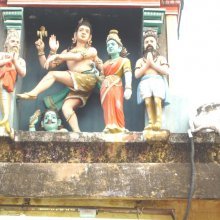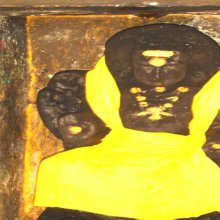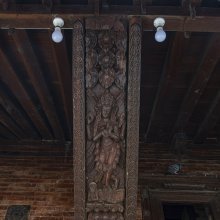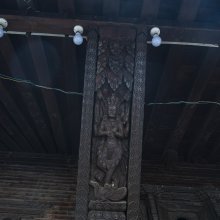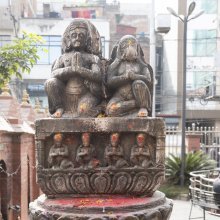Idol: 3 definitions
Introduction:
Idol means something in Hinduism, Sanskrit, the history of ancient India. If you want to know the exact meaning, history, etymology or English translation of this term then check out the descriptions on this page. Add your comment or reference to a book if you want to contribute to this summary article.
Images (photo gallery)
(+47 more images available)
In Hinduism
Vastushastra (architecture)
Source: Shodhganga: Elements of Art and Architecture in the Trtiyakhanda of the Visnudharmottarapurana (vastu)The Idol should be installed in the inner chamber of the Temple (in ancient Indian architecture), according to literature such as the Bṛhatsaṃhitā and the Viṣṇudharmottarapurāṇa, an ancient Sanskrit text which (being encyclopedic in nature) deals with a variety of cultural topics such as arts, architecture, music, grammar and astronomy.—According to the Viṣṇudharmottarapurāṇa, the idol which would be installed in the garbhagṛha i.e., the inner chamber of the temple, with its pedestal, should be lesser by one eighth of the door as the idol could be installed in the particular place without any difficulty. The steps of the temple should be even in numbers and they should not be very narrow or very wide.

Vastushastra (वास्तुशास्त्र, vāstuśāstra) refers to the ancient Indian science (shastra) of architecture (vastu), dealing with topics such architecture, sculpture, town-building, fort building and various other constructions. Vastu also deals with the philosophy of the architectural relation with the cosmic universe.
Shilpashastra (iconography)
Source: Shodhganga: Elements of Art and Architecture in the Trtiyakhanda of the Visnudharmottarapurana (shilpa)Idols of Gods and Goddesses were worshiped since the ancient Vedic time.—The evidence of the presence of idols of gods is found in the Mahābhārata. In the Puranic literature, a great discussion on Iconography can be found. In Sanskrit, different words like mūrti, pratimā, devatārūpa etc. are used to denote image or idol. In the Viṣṇudharmottarapurāṇa the word pratimā is used to denote image and it gives a detail explanation on the characteristics of images of various gods and goddesses in the chapters from 44 to 85.

Shilpashastra (शिल्पशास्त्र, śilpaśāstra) represents the ancient Indian science (shastra) of creative arts (shilpa) such as sculpture, iconography and painting. Closely related to Vastushastra (architecture), they often share the same literature.
India history and geography
Source: Shodhganga: Elements of Art and Architecture in the Trtiyakhanda of the Visnudharmottarapurana (history)Idols were not in their tangible form during Vedic time.—Though during the Vedic time, idols were not in their tangible form, the images of different gods and goddesses used to be imagined by the people of that era. Actually Vedic texts are regarded as the principal sources of all ideologies of Indian culture. So, it can be said that the idea of making images of different gods and goddesses according to their attributes comes from the Vedic texts, where various forms of different deities have been praised.

The history of India traces the identification of countries, villages, towns and other regions of India, as well as mythology, zoology, royal dynasties, rulers, tribes, local festivities and traditions and regional languages. Ancient India enjoyed religious freedom and encourages the path of Dharma, a concept common to Buddhism, Hinduism, and Jainism.
See also (Relevant definitions)
Starts with: Idol worship, Idololenkonyane, Itoli.
Ends with: Ciidol, Kavitol, Mittol, Pulidol, Tchiidol, Utaitol.
Full-text (+1150): Pratima, Devayatra, Rathotsava, Adhivasana, Nirajana, Amaradvija, Murti, Idol worship, Daivata, Devadroni, Bhauta, Prasada, Surarcaveshman, Devala, Marudratha, Deva, Thakkura, Gudideva, Caramurti, Nandadipa.
Relevant text
Search found 140 books and stories containing Idol; (plurals include: Idols). You can also click to the full overview containing English textual excerpts. Below are direct links for the most relevant articles:
Manasara (English translation) (by Prasanna Kumar Acharya)
Chapter 68 - The casting of idols in wax (madhūcchiṣṭa-kriyā)
Chapter 55 - The Jain images (jaina-lakṣaṇa)
Puranic encyclopaedia (by Vettam Mani)
Vishnudharmottara Purana (Art and Architecture) (by Bhagyashree Sarma)
8(a): Image Making: The Concept < [Chapter 5 - Painting and Image Making]
6. The Viṣṇudharmottara-purāṇa and Modern Iconography < [Chapter 6 - Modern Relevance of Different Art Forms and Architecture]
8(b): The Image of Various Gods < [Chapter 5 - Painting and Image Making]
Lord Hayagriva in Sanskrit Literature (by Anindita Adhikari)
Description of the Idols < [Chapter 6]
Legend behind the origin of Hayagrīva Mādhava idol < [Chapter 6]
Iconographical descriptions of Hayagrīva < [Chapter 6]
Chaitanya Bhagavata (by Bhumipati Dāsa)
Verse 1.2.65 < [Chapter 2 - The Lord’s Appearance]
Verse 1.4.20 < [Chapter 4 - Name-giving Ceremony, Childhood Pastimes, and Thieves Kidnap the Lord]
Introduction to chapter 2 < [Chapter 2 - The Lord’s Appearance]
The Padma Purana (by N.A. Deshpande)
Chapter 18 - The Greatness of Puruṣottama < [Section 7 - Kriyāyogasāra-Khaṇḍa (Section on Essence of Yoga by Works)]
Chapter 80 - Month-wise Rites Prescribed for a Viṣṇu Devotee < [Section 5 - Pātāla-Khaṇḍa (Section on the Nether World)]
Chapter 65 - The Slaying of Kālakeya < [Section 1 - Sṛṣṭi-khaṇḍa (section on creation)]
Related products

